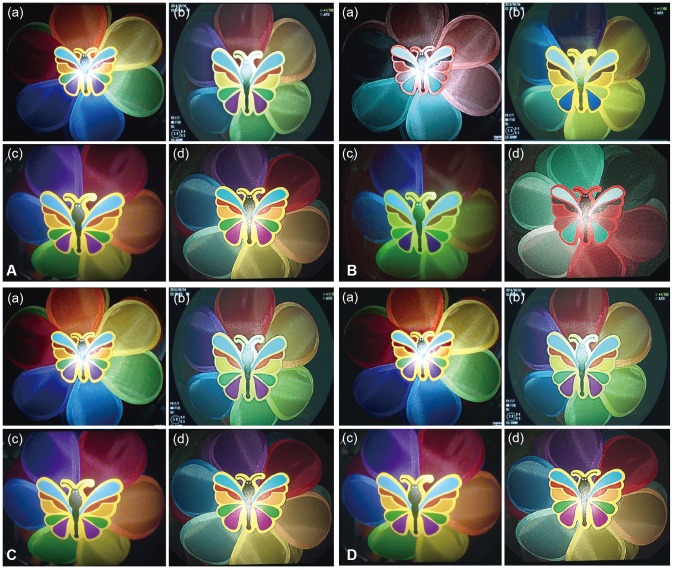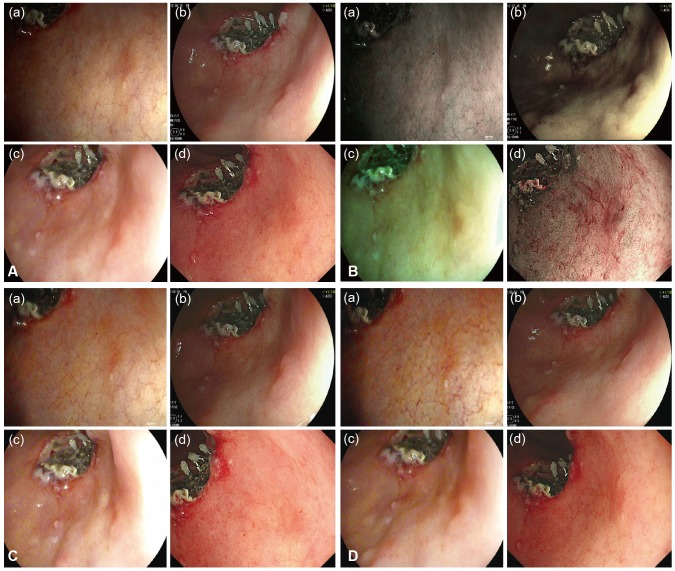Preferences for image quality of products from the four leading companies were surveyed at 4th September 2014. For this survey, Karl Storz (model, Image 1 SPIES; scope, Silver scope 13825NKS), Fujinon (model, EPX-4450HD; scope, 590WR), Olympus (model, CLV-290SL; scope, GIF-H290), and Pentax (model, EPK i7000; scope, EEG29-i10) endoscopes, with the highest image resolution among the products from each of the four companies on the market today, were selected and compared objectively. Preferences were divided into four elements that determine image quality, including elements of definition, boundaries, brightness, and 'light and shade.' A video indicating the butterfly pattern (
in vitro) (
Fig. 1) and actual early gastric cancer II a lesions (
in vivo) (
Fig. 2) on the endoscopic screen was shown to study participants and they were required to respond to the survey. In particular, unique spectral images from each endoscope were compared for boundaries. Comparisons were also performed with images generated using functions unique to the Karl Storz system, since its products were equipped with unique functions for brightness and 'light and shade.' The 209 respondents that participated in the current survey for image quality analysis were made up of 26 nurses, 32 medical students, and 151 GI endoscopy specialists. Based on the outcome of the survey, the selection rate of each element was calculated and analysis was conducted to determine whether there was agreement in the selections for definition, boundaries, brightness, and 'light and shade.' The agreement, in terms of these selections, between the butterfly pattern and gastric lesions was also analyzed for each of the four elements (kappa value, k value). All statistical analyses were performed using SPSS version 19 (IBM Co., Armonk, NY, USA). In terms of the results of the survey, a total of 209 people participated in the survey and there were no missing values. For the purposes of the survey, (a), (b), (c), and (d) shall represent Karl Storz, Fujinon, Pentax, and Olympus, respectively. In the survey results for the butterfly pattern, the selection rate in terms of definition was in the order of (c, 56.9%)>(d, 36.8%)>(a, 5.3%)>(b, 1%); in terms of boundaries was (d, 50.2%)>(c, 32.5%)>(a, 8.6%)=(b, 8.6%); brightness was (a, 32.1%)>(b, 30.6%)>(c, 24.9%)>(d, 12.4%); 'light and shade' was (a, 36.4%)>(c, 34%)>(d, 27.3%)>(b, 2.4%); and the overall preferences were in order of (c, 37.1%)>(d, 31.7%)>(a, 20.6%)>(b, 10.6%). In the survey results for the gastric lesions, selection rate for definition was in the order of (a, 34.9%)>(b, 33.5%)>(d, 23%)>(c, 8.6%); boundaries were (d, 48.3%)>(b, 32.1%)>(a, 11.5%)>(c, 8.1%); brightness was (c, 44%)>(d, 24.9%)>(b, 19.1%)>(a, 12%); 'light and shade' was (a, 32.1%)>(b, 29.7%)>(d, 26.3%)>(c, 12%); and the overall preferences were in the order of (d, 30.625%)>(b, 28.6%)>(a, 22.625%)>(c, 18.175%) (
Tables 1,
2,
Fig. 3). A k value was calculated to determine whether there was agreement in the selection of definition, boundaries, brightness and 'light and shade.' However, the agreement in terms of selection between each product family was low, with a maximum k value of 0.117. The agreement in selection for definition, boundaries, brightness, and 'light and shade' between the butterfly pattern and gastric lesions was also low.
 | Fig. 1Butterfly pattern (in vitro) taken according to each endoscopy company, analyzed on each point of evaluation, namely (A) definition, (B) boundary, (C) brightness, and (D) light and shade.
|
 | Fig. 2Gastric lesion (in vivo) taken according to each endoscopy company analyzed on each point of evaluation, namely (A) definition, (B) boundary, (C) brightness, and (D) light and shade.
|
 | Fig. 3Comparison of preference per product. (A) Butterfly pattern. (B) Gastric lesion.
|
Table 1
Preferences for the Images of the Butterfly Pattern


Table 2
Preferences for Gastric Lesion







 PDF
PDF ePub
ePub Citation
Citation Print
Print






 XML Download
XML Download